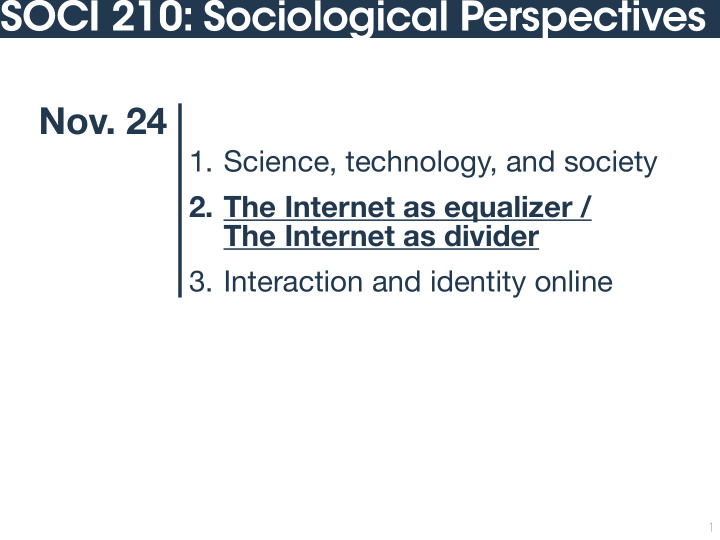



SOCI 210: Sociological Perspectives Nov. 24 1. Science, technology, and society 2. The Internet as equalizer / The Internet as divider 3. Interaction and identity online 1
Internet as Equalizer 2
Communication technology Technologies of communication are hugely impactful on society Communication as the medium of interaction Written language Durable, verifiable, recordable Trade, laws, long-distance communication, literature, … Printing Reproducible, mass distribution Democratization of text (Martin Luther) Walter Benjamin: “The Work of Art in the Age of Mechanical Reproduction” 3
Communication technology Technologies of communication are hugely impactful on society Communication as the medium of interaction Telecommunications “Instant” broadcasts Global availability of news Mass media and culture (Hollywood) The Internet Email, World Wide Web Person-to-person communication Online identities 4
Internet as equalizer Globalized communication • Popular idea that instant, e ff ortless communication is widely available to everyone (We will problematize this in a moment) Lowered barriers • Common idea behind theories of modernization • Geographic, political, cultural, and economic barriers are easier to cross “The World is Flat” • Thomas Friedman (2005) • Utopian ideal of hyper-modernized globe • Realization of free-market ideal 5
Internet as equalizer Internet undoubtedly breaks down some social barriers • E ff ort required to publish information to a global audience (or a specific person) is extremely low • Special-interest information and support communities are widely accessible Marginalized communities can cast a wider social support net • Populations with grievance can find each other Disparate individuals can become a “group” 6
Internet and mobilization Recombinative culture • Cognitive Surplus (Clay Shirky, 2010) • Grass-roots creative communities bandcamp.com, github.com, archiveofourown.org 7
Internet as Divider 8
Digital divide Percentage of households with Internet Access Source: International Telecommunication Union https://www.itu.int/en/ITU-D/Statistics/Pages/stat/default.aspx 100 Developed Countries 80 60 Developing Countries 40 20 0 2006 2008 2010 2012 2014 2016 9
Digital divide Infrastructure inequality • Physical infrastructure of the Internet focussed on wealthy parts of wealthy countries Access and bandwidth correlated with wealth and power • Hardware expensive for individuals and institutions Cultural inequality • Internet is designed by and for Western Europeans and North Americans Euro-centric URLs, programming languages, documentation, … 10
Digital divide Infrastructure inequality • Physical infrastructure of the Internet focussed on wealthy parts of wealthy countries Access and bandwidth correlated with wealth and power • Hardware expensive for individuals and institutions Cultural inequality • Internet is designed by and for Western Europeans and North Americans Euro-centric URLs, programming languages, documentation, … Ray Tomlinson inventing email 11
Digital divide Infrastructure inequality • Physical infrastructure of the Internet focussed on wealthy parts of wealthy countries Access and bandwidth correlated with wealth and power • Hardware expensive for individuals and institutions Cultural inequality • Internet is designed by and for Western Europeans and North Americans Euro-centric URLs, programming languages, documentation, … Knowledge inequality • Technical knowledge Email, web navigation, word processing, etc. • Social knowledge Etiquette, discernment of legitimate sources, etc. 12
Structural inequality Forces of structural inequality • Evan a “flat world” will develop structural inequalities • Matthew e ff ect (path dependency, preferential attachment) “Rich get richer, poor get poorer” • Concentration of power Twitter accounts with many followers will attract even more Amazon books with lots of reviews will sell more Academic articles with lots of citations will be cited more • Small differences compound over time 13
Embedded inequality Automation of communications media • Filtered content, targeted ads, search, … Technology embeds existing biases • Racial, ethnic, gender, and class prejudices are built into technology Roth, Lorna. “Looking at Shirley, the Ultimate Norm: Colour Balance, Image Technologies, and Cognitive Equity.” Canadian Journal of Communication 34, no. 1 (March 28, 2009). 14
Embedded inequality New media and the reproduction of inequality • Artificial intelligence / machine learning cannot be neutral • Biases of scientists Introduced through categories and implicit assumptions • Biases of society Introduced through data availability and model training 15
Embedded inequality 16
Technology as divider Technology as tool of oppression • Ubiquity of digital communication opens new channels for systems of oppression • Surveillance Location, content, association, etc Foucault’s panopticon • Harassment, cyber-bullying, doxxing Availability of information and access to social networks Gamergate 17
Recommend
More recommend